Slaters explained

Introduction
Slaters (woodlice) belong to the order Isopoda, which is a part of the arthropod class Crustacea. Most Isopoda are marine dwellers, but slaters (suborder Oniscidea) have become fully terrestrial.
Slaters are conspicuous and easily recognised by their dorso-ventrally flattened segmented bodies, and seven pairs of legs. New Zealand slaters range in size from several millimetres to more than 2 cm, but most are under 1 cm in length. Their colour is usually in the shades of grey or brown, often mottled with yellow. There is often a lot of variation in colour and pattern among individuals of the same species, and many species vary in colour to match their environment (e.g., Actaecia euchroa on yellow sand and black sand beaches will be coloured to blend with the sand colour).
Visit the SoilBugs website for notes on slater biology.
Slater body
The slater body is divided into three regions – head (cephalon), thorax (pereon), and abdomen (pleon).
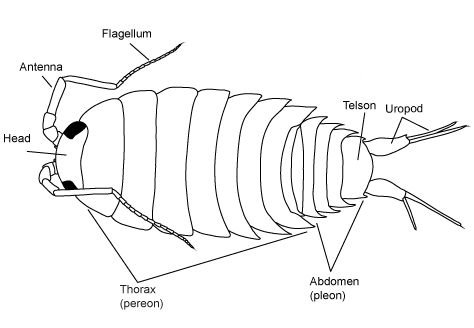
The head is covered with a single shield, sometimes with rounded lobes or processes on the frontal or anterolateral margin. Chewing mouthparts are located on the head ventrally.
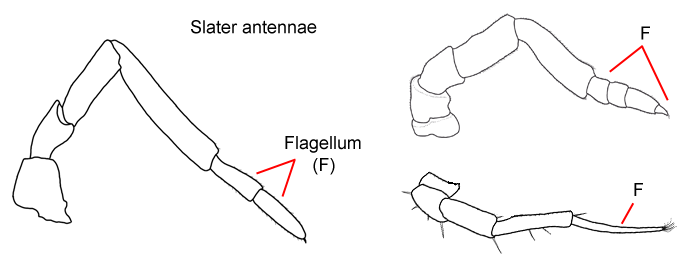
The head appears to bear one pair of antennae, although there are actually two pairs. The first pair of antennae (“antennules”) are very small and inconspicuous; they are thought to have a chemosensory function (smell and taste). The second pair of antennae (thereafter “antennae”) are large and prominent. Each antenna consists of five basal segments, and a processed articulated distal part called a flagellum. The number of articles (segments) in the flagellum is an important taxonomic character.
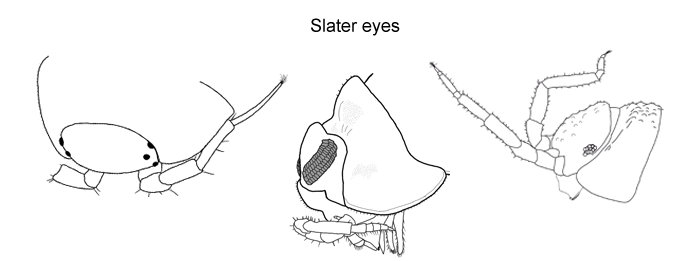
Two eyes are usually visible on the sides of the head. In some species each eye is composed of a single ocellus, or a small group of ocelli (e.g., a group of three ocelli in family Styloniscidae). In other species the eyes are larger and have dozens or even hundreds of closely associated ocelli (compound eye).
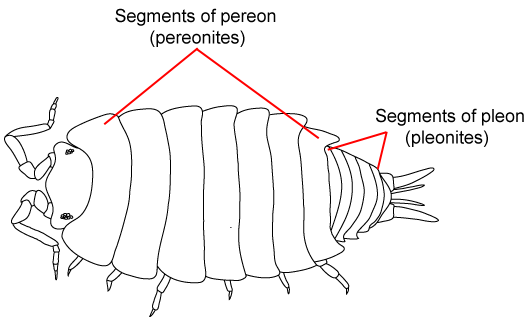
The pereon (thorax) is the largest part of the body. It is comprised of seven segments and covered with seven overlapping dorsal plates (tergites), often with projections (epimeres) at the sides. On the underside, each segment of pereon bears a pair of walking legs (pereopods). All legs are of similar size and structure. In females the bases of some pereopods can have leaf-like extensions which form a brood pouch in which females carry eggs or newly hatched young.
The pleon (abdomen) has 5 segments. Each segment (pleonite) is covered with a tergite and often has epimeres extending postero-laterally. Each abdominal segment also bears a pair of legs (pleopods), which are flattened and modified for respiration. In males the first two pairs of pleopods are modified to form copulatory structures. To function, pleopods need to remain covered with a thin film of water, which is why slaters prefer damp, sheltered environments. Some species have internal breathing structures within pleopods called pleopodal lungs. In live animals the pleopodal lungs are seen as small white patches on the ventral side (see the photo at the top left of this page), and these species are more tolerant of dryness. In preserved animals pleopodal lungs are difficult to see.
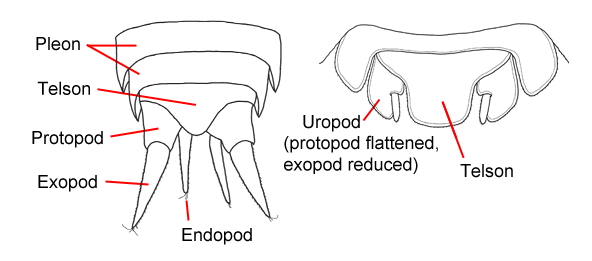
The pleon ends with a small sixth segment called the telson. The telson bears a pair of appendages called uropods. Each uropod consists of a basal segment (protopod), and two unarticulated rami - an inner endopod and an outer exopod. In some species both rami are elongated and visible. In forms which roll into a ball the rami of uropods are usually reduced.
